Study on the Performance of Spherical Tail Bearing based on Finite Element Method
2018-10-12LIULiangTANGYujiaXUYichi
LIU Liang,TANG Yu-jia,XU Yi-chi
(1.Marine Design&Research Institute of China,Shanghai 200011,China;2.Shanghai Haixun Mechanical and Electronic Engineering Co.,Ltd.,201700,China)
Abstract:Spherical tail bearing is a composite bearing which combines the joint bearing with the ordinary water lubricated tail bearing.The ‘edge effect’caused by the propeller can be reduced by the function of automatic heart adjustment of the joint bearing,and increasing the tail shaft and bearing contact area,reducing the maximum contact pressure and improving lubricating performance.This paper uses the ANSYS finite element method to simulate and analyse the performance of the spherical tail bearing.The results show that the spherical tail can increase the contact area between tail shaft and bearing and make the distribution of contact pressure more uniform.Compared with ordinary tail bearing,the maximum contact pressure decreases by 22 percent,and the stiffness reduces.The finite element simulation in this paper provides a theoretical basis for the application of spherical tail bearing on the ship shafting.
Key words:spherical tail bearing;joint bearing;contact pressure;finite element
0 Introduction
The ship propulsion system consists of the propulsion shafting,the lubrication system,the sealing device,and so on.The propulsion shafting is composed of rear tail bearing,middle tail bearing,front tail bearing,and so on.Being an important part of the external and internal exchange,the rear tail bearing supports the tail shaft and propeller and has the worst working environment[1-3].Because of the cantilever load of propeller and various loads in the operation of the shaft system,the pressure distribution of the rear tail is uneven and the vibration,etc occur[4-5].
In order to solve ‘edge effect’ of the tail bearing caused by the propeller,a new type of ship tail bearing-spherical tail bearing is proposed in this paper,which is a composite bearing combing the joint bearing with the ordinary tail bearing.Joint bearing is a kind of special sliding bearing with friction pair as spherical surface,which has been widely used in military machinery,architecture and aviation[6-9].No relevant literature has been found in the application of the ship field.The joint bearing is composed of outer ring and inner ring,as shown in Fig.1.The outer ring adopts a split type structure,arranging the inner ring in the lower half circle,folding the another half circle through the position pin and being locked by the four angles bolt.
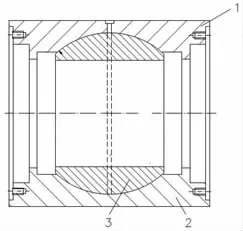
Fig.1 Joint bearing sketch
1 Type of spherical tail bearing
The spherical tail bearing structure presented in this paper is shown in Fig.2.The sealing device of the bearing consists of V seal ring,pressing ring and cap,it can solve the problem of waterproof and antifouling.The sealing ring is fixed between the outer ring of the joint bearing and the tail bearing by the pressing ring,the gland and the screw.When the gland is pressed on the sealing ring through the pressing ring,the sealing ring produces certain compression deformation,so that it can be well attached to the outer surface of the tail bearing.The disturbance of the joint bearing is very small,so the small rotation of the inner ring has little influence on the sealing ring.
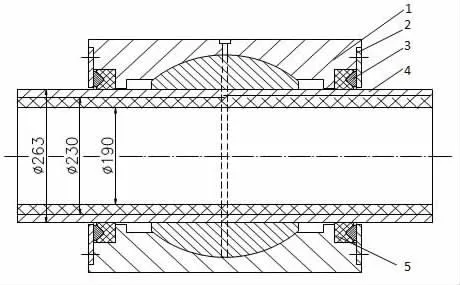
Fig.2 Structural representation of spherical bearing
Fluorine rubber is used in V sealing ring.Fluorine rubber not only has good flexibility,but also has good corrosion resistance and wear resistance,and can ensure the sealing effect of the bearing.Considering the bearing capacity,wear resistance and corrosion resistance requirements of the joint bearing,the outer ring is chosen with bronze materials(such as ZCuSn10-1)with good corrosion resistance,small friction coefficient and strong abrasion,and the corrosion-resistant stainless steel(such as 9Cr18)is used for inner rings and bolts[10].
2 The establishment of spherical tail bearing model
The model is modeled based on the data of a real ship’s shafting.The shafting consists of three bearings,including the rear tail bearing,the middle tail bearing and the front tail bear-ing,as shown in Fig.3.The weight of propeller is 6 kN,the material of tail bearing lining is rubber,while the material of axle sleeve is copper,the material of shaft is carbon steel.The gap between the tail shaft and the tail bearing is 2 mm.

Fig.3 Schematic diagram of shafting structure
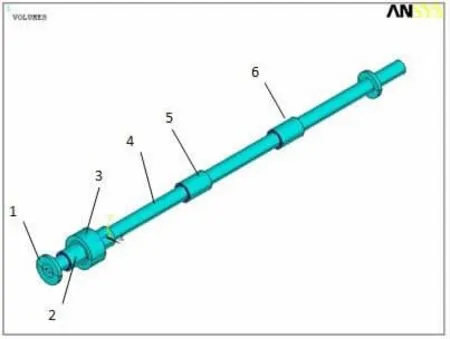
Fig.4 Finite element model of spherical tail bearing shafting
In order to make the result more accurate,the whole shafting is modeled by the solid 45 element in the ANSYS[11].The joint bearing is established on the rear tail bearing base on the above model.In order to simplify the model,the sealing device is ignored during the modeling process because it does not influence the analysis result.The finite element model,as shown in Fig.4,has 104 120 units and 107 360 nodes.
3 Analysis of simulation results
3.1 Inner spherical surface deformation and contact pressure cloud chart of spherical tail bearing
Fig.5 is inner spherical surface deformation and contact pressure cloud chart of spherical tail bearing.It shows that the maximum deformation of the inner ring of the spherical tail bearing is 0.531E-04 m.Shown in Fig.5(b),the maximum contact pressure is 358 011 Pa(0.358 MPa)at the bottom of the contact surface near the edge area,this is due to the gravity of the propeller,the contact pressure of the non bearing part of the contact surface is 0 MPa.

Fig.5 Inner spherical surface deformation and contact pressure cloud chart of spherical tail bearing
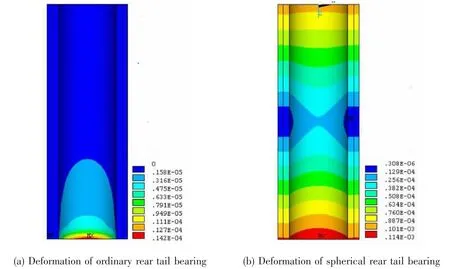
Fig.6 Deformation cloud chart
3.2 Comparison with ordinary rear tail bearing deformation
Fig.6(a),(b)is ordinary rear tail bearing and spherical rear tail bearing(rubber liner)deformation cloud chart.The comparison of the two diagrams can be seen:(1)The maximum deformation of the two types of bearing is 0.142E-03 m and 0.114E-04 m.(2)The contact area of the rubber inner part of spherical tail bearing is larger than that of the ordinary tail bearing,and the contact is more uniform,but the deformation of the both ends is slightly larger.This is related to the length of the inner ring of the joint bearing shorter than the length of the rubber liner,resulting in the stiffness of both ends is reduced.
3.3 Comparison with ordinary rear tail bearing contact pressure[12]
Fig.7(a),(b)is ordinary rear tail bearing and spherical rear tail bearing(rubber liner)contact pressure cloud chart.The comparison of the two diagrams can be seen:The maximum contact pressure of the two types of bearing is 0.251E+06 Pa and 0.195E+06 Pa,the latter is about 3/4 of the former,which indicates that the maximum contact pressure of the rubber liner of the spherical tail bearing is lower.
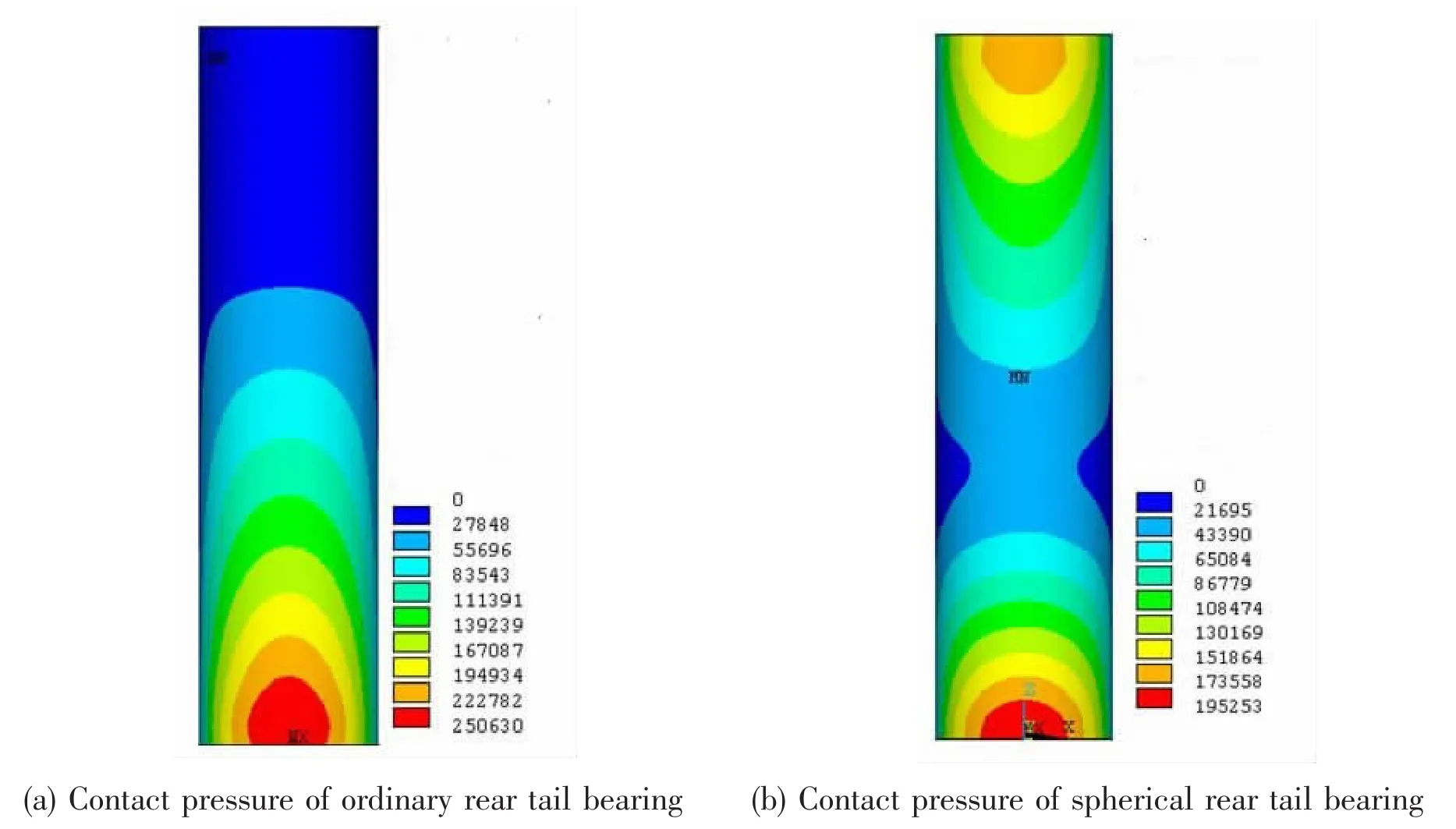
Fig.7 Contact pressure choud chart
4 Stiffness analysis of spherical tail bearing
4.1 Finite element model

1.Joint bearing;2.Bearing sleeve;3.Rubber liner;4.Mandrel
In order to simulate and calculate the stiffness of spherical tail bearing,the mandrel and the bearing are assembled as a whole.Then the force acting on the bearing is simulated by mandrel weight,which means the force being the weight of mandrel is axially uniform on the bearing and the bearing stiffness can be calculated by counting the corresponding displacement.The finite element model of the spherical bearing and mandrel is shown in Fig.8.The outer surface of the spherical tail bearing is fully constrained,and the axial ends of the mandrel are constrained by the axial direction.The model has 29 472 units and 33 892 nodes.
4.2 Result analysis
Considering that the spherical tail bearing is composed of joint bearing and ordinary tail bearing,their bearing materials are different,the bearing displacement may not have a linear relationship with the bearing load.So when calculating the bearing stiffness,the load values 5 kN,10 kN,and the corresponding and bearing stiffness are calculated respectively.Then the average stiffness is taken as the average value of the spherical tail bearing.
The results of stiffness calculation for spherical tail bearing are listed in Tab.1.
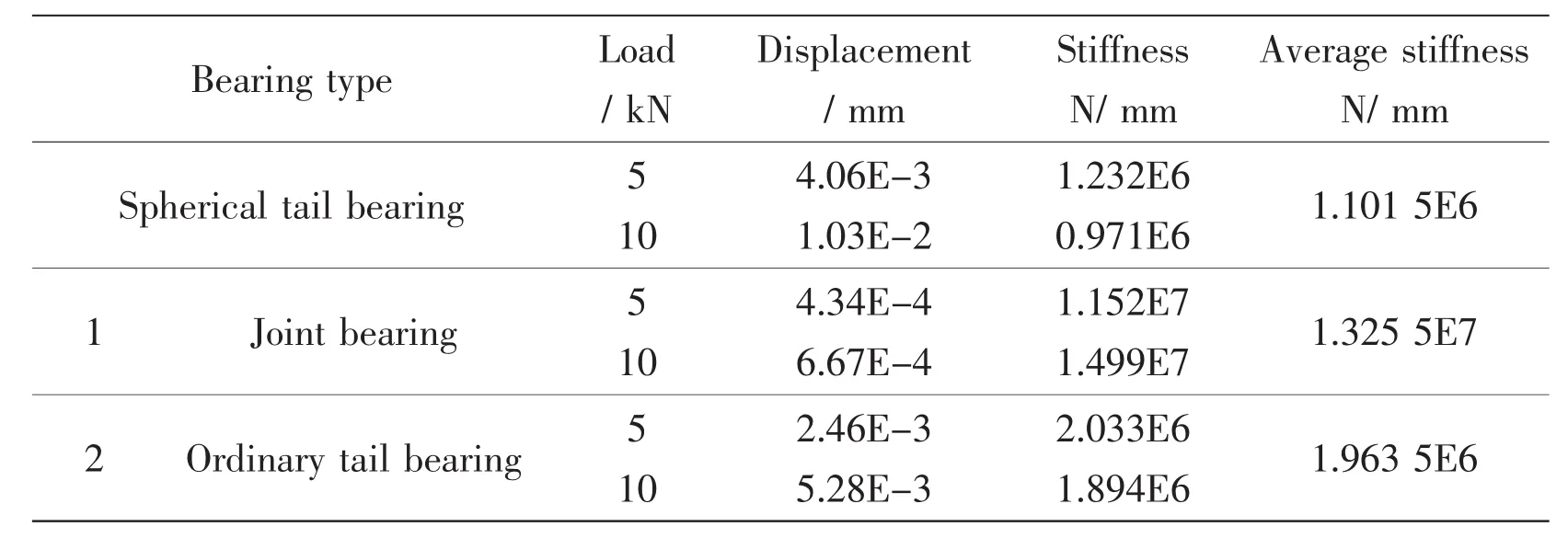
Tab.1 The stiffness of spherical tail bearing
According to Tab.1,the corresponding stiffness of spherical tail bearing is 1.232E6 N/mm and 0.971E6 N/mm under the action of 5 kN and 10 kN respectively,the average stiffness is 1.101 5E6 N/mm,which is lower than that of the joint bearing stiffness(1.325 5E7 N/mm)and the ordinary tail stiffness(1.963 5E6 N/mm).
5 Conclusions
(1)Through the finite element modeling analysis,it is concluded that the spherical tail bearing has stronger self position function.Compared with the ordinary tail bearing,its contact area is larger,and the maximum contact pressure can be reduced by 22 percent.The average stiffness is 1.101 5E6 N/mm,lower than the composition part of the joint bearing stiffness(1.325 5E7 N/mm)and the ordinary tail stiffness(1.963 5E6 N/mm).
(2)Spherical tail bearing structure is complex and the process of manufacturing and maintenance is more troublesome.For the convenience of the installation of the outer and inner ring,the outer ring must be designed as a split form.At the same time,a column pin which is used to prevent the inner ring from rotating to the outer ring and sealing devices need to be designed.
The relevant work in this paper can provide theoretical support for the application of spherical tail bearing on the ship.
杂志排行
船舶力学的其它文章
- Numerical Calculation of Hull Wave-making Resistance by Three-dimensional RANS Method
- Mathematical Representation of a 3-D Translating Source Green Function and its Fast Integration Method
- Measures to Restrain Propeller-Hull Vortex Cavitation and Some Discussions
- Evaluation of Turbulence Models for the Numerical Prediction of Time-dependent Cavitating Flow During Water Entry of a Semi-closed Cylinder
- Investigation on Higher-Order Responses of Vortex-Induced Vibration for a Mounted Cylinder
- Dynamic Property and Motion Simulation of Atmospheric Diving Suit
